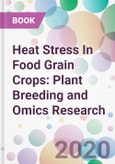Authors of the respective chapters explain the importance of harnessing a diverse crop genepool for sustaining crop production under conditions of increasing heat stress. Readers will be able to understand the relevance of functional genomics in elucidating candidate genes and their regulatory functions contributing to heat tolerance.
Table of Contents
Chapter 1 Mitigating Heat Stress in Wheat: Integrating Omics Tools- With Plant Breeding
- Introduction
- Impact of Heat Stress on Wheat Production
- Heat Stress, Extent of Damage/Threat to Wheat Area and Mechanisms Affected
- Mechanism of Heat Tolerance Adoption by Plants
- Avoidance Mechanisms by Way of Phenotypic Adjustments
- Tolerance Mechanisms
- Traits of Importance for Heat Tolerance and Their Phenotyping
- Techniques
- Canopy Temperature
- Leaf Chlorophyll Content
- Canopy Greenness/Stay Green Canopy
- Earliness Perse in Wheat
- Photosynthetic Efficiency
- Cell Membrane Thermal Stability
- Wheat Improvement for Heat Tolerance, Integrating Plant
- Breeding and Omics Tools
- Breeding for Heat Tolerance in Wheat
- Germplasm Identification for Heat Tolerance
- Heat Tolerant Varieties by Conventional Selection
- Qtls for Heat Tolerance
- Marker Assisted Recurrent Selection for Improving Heat Stress Tolerance
- Omics Approaches for Identification of High Temperature Stress
- Tolerance Genes
- Transcriptomics
- Proteomics
- Metabolomics
- Ionomics
- Functional Genomics
- Genetic Engineering
- Genomics Assisted Breeding
- Integration of Omics Tools for Enhancing Thermotolerance
- Conclusion
- Consent for Publication
- Conflict of Interest
- Acknowledgements
- References
Chapter 2 Genetic Enhancement of Heat Tolerance in Maize Through
- Conventional and Modern Strategies
- M. G. Mallikarjuna, Jayant S. Bhat, Firoz Hossain, Palanisamy Veeraya, Akshita Tyagi
- Chikkappa G. Karjagi and H. C. Lohithaswa
- Introduction
- The Responses of Maize to Heat Stress
- Morphological Responses
- Physiological Responses
- Photosynthesis
- Water Relations and Osmotic Adjustments
- Oxidative Stress
- Hormonal Response
- Molecular Responses
- Heat Shock Proteins (Hsps)
- Signalling Transduction of Heat Stress
- Adaptive Mechanisms for Heat Tolerance in Maize
- Functional Genomics
- Maize Breeding for Heat Tolerance
- Screening Methodologies and Heat Tolerance Indices
- Genetics of Heat Tolerance in Maize
- Conventional Breeding
- Genomics Assisted Breeding for Heat Tolerance
- Genetic Engineering
- Prospects
- High Throughput and Reliable Phenotyping
- Deciphering the Interactions Between Heat and Other Abiotic Stresses on Maize
- Dissecting Detailed Molecular Mechanisms and Signalling Cascades of Heat Stress
- Tolerance in Maize
- Use of Next-Generation Breeding Tools
- Policy Support
- Consent for Publication
- Conflict of Interest
- Acknowledgements
- References
Chapter 3 Breeding Pearl Millet for Heat Stress Tolerance
- P. Sanjana Reddy
- Introduction
- Heat Stress at Different Phenological Stages
- Heat Tolerance Mechanisms in Crops
- Screening Methodologies
- Breeding for Heat Tolerance
- Conclusions
- Consent for Publication
- Conflict of Interest
- Acknowledgements
- References
Chapter 4 Advances in Breeding for Heat Stress Tolerance in Chickpea
- B. S. Patil, Jayant S. Bhat, A. G. Vijaykumar, C. Bharadwaj and U. C. Jha
- Introduction
- Effect of Heat Stress at Various Plant Stages
- High Throughput Phenotyping for Identifying Heat Tolerant Genotype
- Genetic Resources for Heat Stress Tolerance
- Breeding Approaches for Designing Heat Stress Tolerance Crop Plant
- Traits Contributing for Heat Stress Tolerance
- Genomic Resources for Heat Stress Tolerance
- Functional Genomics for Heat Stress Tolerance
- Prospects of Innovative Breeding Approaches for Heat Stress Tolerance in Crop Plant
- Summary and the Future Prospects
- Consent for Publication
- Conflict of Interest
- Acknowledgements
- References
Chapter 5 Genetic Improvement of Groundnut for Adaptation to Heat
- Stress Environments
- Murali T. Variath, Dnyaneshwar B. Deshmukh, Sunil Chaudhari, Seltene Abady,
- Swathi Gattu and Janila Pasupuleti
- Introduction
- Heat Stress and Its Effect on Different Life Stages of Groundnut
- Germination, Seedling Emergence, and Vegetative Growth
- Reproductive Growth
- Nodulation and Nitrogen Fixation
- Peg, Pod and Seed Development
- Yield and Associated Traits
- Mechanism of Heat-Stress Tolerance
- Short-Term Avoidance/Acclimatization Mechanisms
- Tolerance Mechanisms
- Cell Membrane Injury (Cmi)
- Accumulation of Compatible Osmolytes Under Heat Stress
- Photosynthetic Characteristics Under Heat Stress
- Assimilate Partitioning Inside Plant System Under Heat Stress
- Reactive Oxygen Species (Ros) and Antioxidant Potential Under Heat Stress
- Production of Heat Shock Proteins (Hsp)
- Screening Techniques for Heat-Stress Tolerance
- Field Screening Under Heat-Stress Environment
- Glasshouse Screening Method
- Temperature Induction Response
- Detached Leaf Assay
- Heat-Stress Tolerant Genotypes of Groundnut
- Key Traits for Selecting Heat-Stress Tolerant Genotypes
- Pod Yield and Associated Traits
- Heat Susceptibility Index
- Cellular Membrane Thermostability
- Chlorophyll Fluorescence
- Pollen Characteristics
- Identification of Quantitative Trait Loci (Qtl)/Genes Linked To
- Heat-Stress Tolerance
- Omics Tools for Heat Tolerance in Groundnut
- Future of Breeding Heat-Stress Tolerant Groundnut
- Conclusion
- Consent for Publication
- Conflict of Interest
- Acknowledgements
- References
- Manu Priya, Aditya Pratap, Debjoti Sengupta, Kadambot H.M Siddique, N.P. Singh,
- Uday Jha and Harsh Nayyar
- Introduction
- Growing Conditions and Status of Mungbean Cultivation
- The Nature of Heat Stress and Crop Response
- Effects of Heat Stress
- Growth and Phenology
- Heat Stress and Reproductive Development
- Physiological and Biochemical Effects
- Genotypic Variance and Heat Tolerance
- Agronomic Practices for Heat Resilience
- Soil and Water Management
- Optimum Sowing Time and Nutrient Management
- Genetic Management
- Screening Germplasm for Heat Stress Tolerance
- Biotechnological/Transgenic Approach for Improving Heat Tolerance
- Exogenous Application of Thermo-Protectants
- Conclusions
- Consent for Publication
- Conflict of Interest
- Acknowledgements
- References
Chapter 6 Mungbean and High-Temperature Stress: Responses And
- Strategies to Improve Heat Tolerance
- Subject Index
Author
- Uday Chand Jha
- Hasrh Nayyar
- Sanjeev Gupta








